
![]() Prerequisite: The "SmartTemplates" license is required for this functionality. A group template also has to comprise at least one sequence with page output and at least two sequences with page input.
Prerequisite: The "SmartTemplates" license is required for this functionality. A group template also has to comprise at least one sequence with page output and at least two sequences with page input.
You can control how sequences that process pages are submitted automatically to different subsequent sequences through the use of conditions. In other words, you can define conditions that specify when the documents will be submitted to which subsequent sequence.
If the requirements are met and there are at least two sequences with page input in the group template, proceed as follows:
1.Use "Drag & Drop" to draw a line that connects the sequence with page output (e.g. a Qualify sequence) with the first downstream sequence with page input (e.g. a Prepare sequence).
2.Then draw a second line that connects the same sequence with page output and the second downstream sequence with page input (e.g. another Prepare sequence).
3.The moment you release the mouse button after drawing the connecting line, the “Conditional processing” dialog opens.

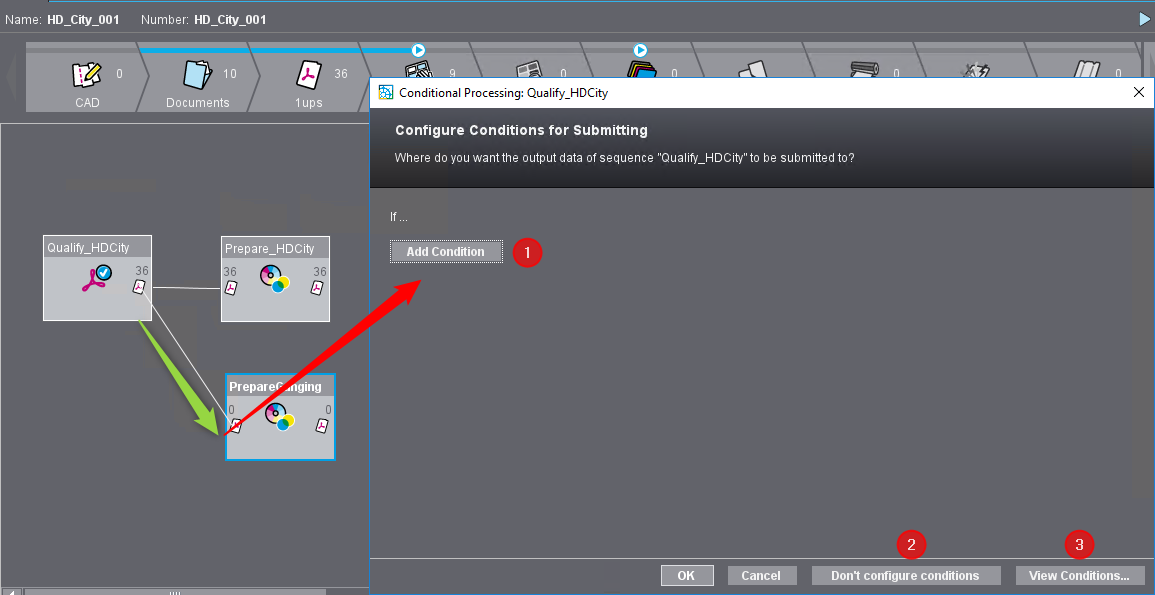
4.You can choose between the following options:
•Add Condition (1)
•Don't configure conditions (2)
•Manage Conditions (3).
The procedure is explained below using a few examples.
5.If you add a new condition (1), you must first enter a name.
6.Enter the name and confirm the "Entering names" dialog with "OK".
7.The dialog "Conditional Processing: Condition Management" opens:

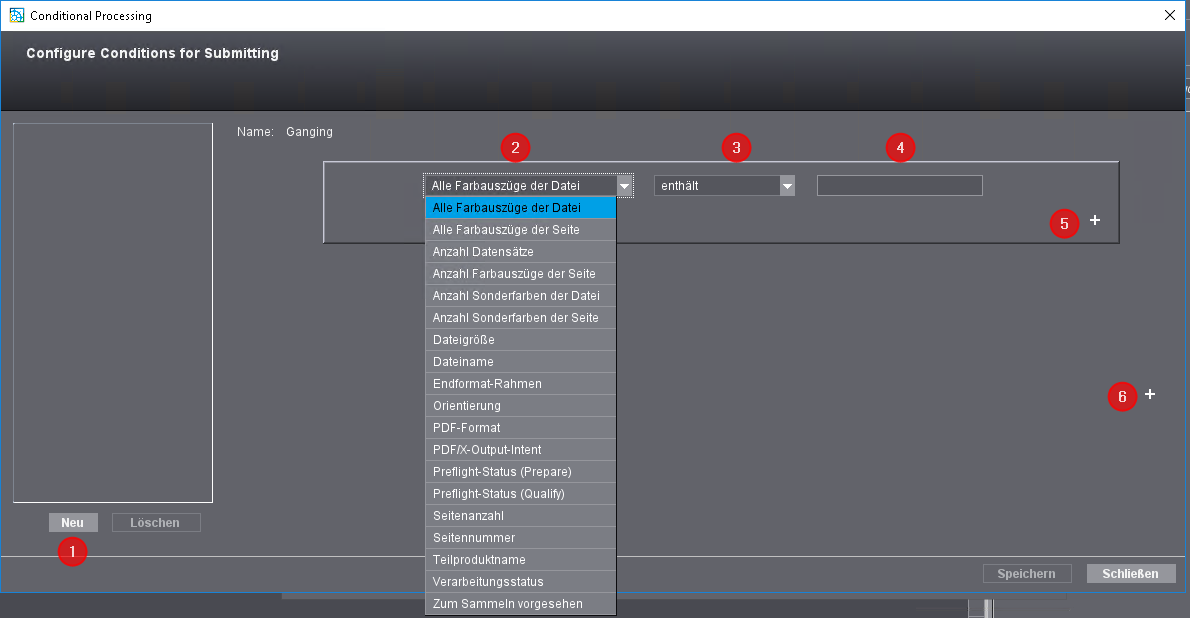
8.Here, you can click "New" (1) to create more new conditions. You define the current condition by selecting the first condition parameter in the parameter selection list (2). The following condition parameters are available:
Condition parameters | Logic links | Value |
|---|---|---|
All separations in file: (Relates to the entire PDF document) | •contains •doesn't contain •equals •not equal | Freely editable |
All separations in page: (relates to the currently edited page) | •contains •doesn't contain •equals •not equal | freely editable |
No. of Records: (Applicable to PDF/VT files with multiple data sets) | •less than •less than or equal to •equals •not equal •greater than or equal to •greater than •Multiple of | freely editable |
Number of separations in page | •less than •less than or equal to •equals •not equal •greater than or equal to •greater than •Multiple of | freely editable |
Number of spot colors in file | •less than •less than or equal to •equals •not equal •greater than or equal to •greater than •Multiple of | freely editable |
Number of spot colors in page | •less than •less than or equal to •equals •not equal •greater than or equal to •greater than •Multiple of | freely editable |
File Size | •less than •less than or equal to •equals •not equal •greater than or equal to •greater than •Multiple of | freely editable |
File name | •contains •doesn't contain •equals •not equal | freely editable |
Trim Box | •less than •less than or equal to •equals •not equal •greater than or equal to •greater than •Multiple of | Input of values for X and Y |
Orientation: (Portrait or landscape format) | •equals •not equal | •Portrait •Landscape |
PDF format (PDF version) | •equals •not equal | •PDF 1.3 •PDF 1.4 •PDF 1.5 •PDF 1.6 •PDF 1.7 |
PDF/X output intent | •contains •doesn't contain •equals •not equal | freely editable |
Preflight Status (Prepare) | •equals •not equal | •Ok •Warning |
Preflight Status (Qualify) | •equals •not equal | •Ok •Warning |
Number of pages: (Number of page in the PDF document) | •less than •less than or equal to •equals •not equal •greater than or equal to •greater than •Multiple of | freely editable |
Page number (Lets you control processing relative to the specified page number) Note: "Page number" property: For example, this lets you set the submit process separately for odd and even pages. The page numbers in the document are assessed. | •less than •less than or equal to •equals •not equal •greater than or equal to •greater than •Multiple of | freely editable |
Product part name (The name of the product part, for example "EN_Cover" is used as a criterion) | •contains •doesn't contain •equals •not equal | freely editable |
Processing state: (this is where the processing state of the PageOutput sequence is used as criterion) | •equals •not equal | •Ok •Warning |
Ganging Intended: (for gang jobs) | •Yes •No | (no value) |
9.The list box with conditional criteria (3) depends on the selected condition parameter and accordingly contains different items.
10.Enter the value the condition must meet in the Value box (4). For some condition parameters, a list box may also be available here instead of an input field, e.g. for the "PDF format" parameter.
![]() Note: Condition formats for submission that you define using freely editable text are not case-sensitive. For example, if you define "File name" as a condition, it does not matter whether you write the file name in lower case, in upper case or a mixture of both.
Note: Condition formats for submission that you define using freely editable text are not case-sensitive. For example, if you define "File name" as a condition, it does not matter whether you write the file name in lower case, in upper case or a mixture of both.
11.You can add another condition by clicking the "Plus symbol" (5) After clicking, a new set of criteria and a selection list in which you can select the type of link ("and" or "or") are added.
12.You can add another condition by clicking the second "Plus symbol" (6) Here, too, a new main condition and a selection list in which you can select the type of link ("and" or "or") are added after clicking.
13.To remove a condition, a supplementary condition or a main condition, click on the associated minus sign.
Below are some examples of how to create conditions.
Example: Size of the trim box as a condition
You can select the size of the trim box as a criterion in the list box of condition criteria in the "Create and Manage Conditions" dialog. The following conditions for comparison are then available to you:
•less than
•less than or equal to
•equals
•not equal
•greater than or equal to
•greater than
Enter a reference box size (in mm) as a comparison. "less" or "greater" is compared based on the following rules:
•A trim box is smaller than a reference box if the trim box fits into the reference box, either portrait or landscape. This means, if the height or width of the trim box is smaller than the width of the reference box or if the height or width of the trim box is smaller than the height of the reference box. In this process, the height or width of the trim box (but not both at the same time) may be just as high or wide as the related dimension of the reference box.
•The following applies: A trim box is bigger than a reference box if the reference box fits into the trim box.
•The size of a trim box is equal to the size of the reference box if the sizes of both boxes are the same, either directly or rotated by 90°.
•The tolerance for size comparisons is 1 pt.
"Multiple of" operand
You can use this operand to control conditional submitting, for example, based on the page number in the PDF document. For example, if "Page number / Multiple of / 4" is set as the condition, all document pages whose page number is a multiple of 4 are submitted to the related branch. For example, in a 32-page document, pages 4, 8, 12, 16, 20, 24, 28 and 32 are submitted to the branch concerned, while the other pages are submitted to the forward branch. In other words, the branching condition is not met for these pages. The condition is not met either if the parameter is "Multiple of 0" or if the page number = 0 in the document.
Example 1: Submit different orientations to different proofers
A group template comprises a Qualify and a Prepare sequence (both are linked), and two PageProof sequences with different proofers (Epson and HP).
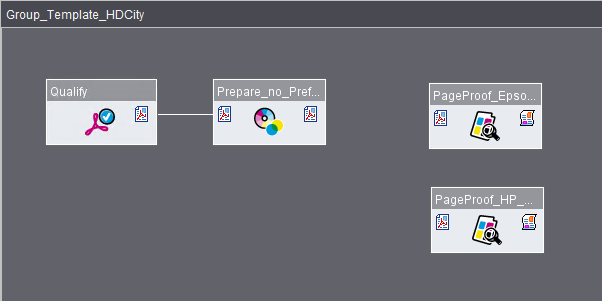
Automatic submission is to work as follows: pages in Portrait orientation are submitted to the Epson proofer, whereas pages in Landscape orientation are submitted to the HP proofer.
Procedure:
1.First draw a connecting line between the Prepare sequence and the PageProof sequence set up for the Epson printer. You can use the context menu command "Open" or key shortcut: Command + O to define conditions for this link. The "Configure Conditions for Submitting" dialog opens.
2.You can also draw a second connecting line between the Prepare sequence and the PageProof sequence set up for the HP printer. In this case, the "Configure Conditions for Submitting" dialog opens automatically as soon as you release the mouse button:

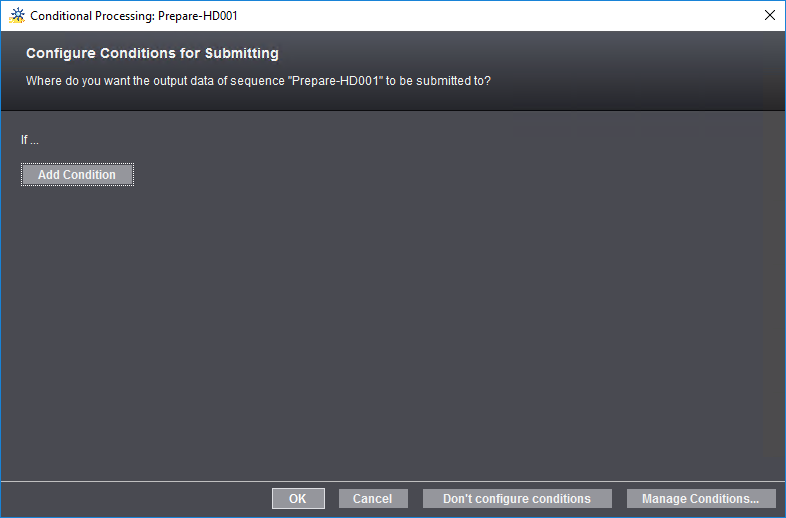
The screenshot shows the state without any condition set up yet. In this section you configure conditions for submitting.
3.Click "Manage Conditions". First, enter a name for the new condition - "Portrait" in the example - and confirm with "OK". The "Create and Manage Conditions" window opens:

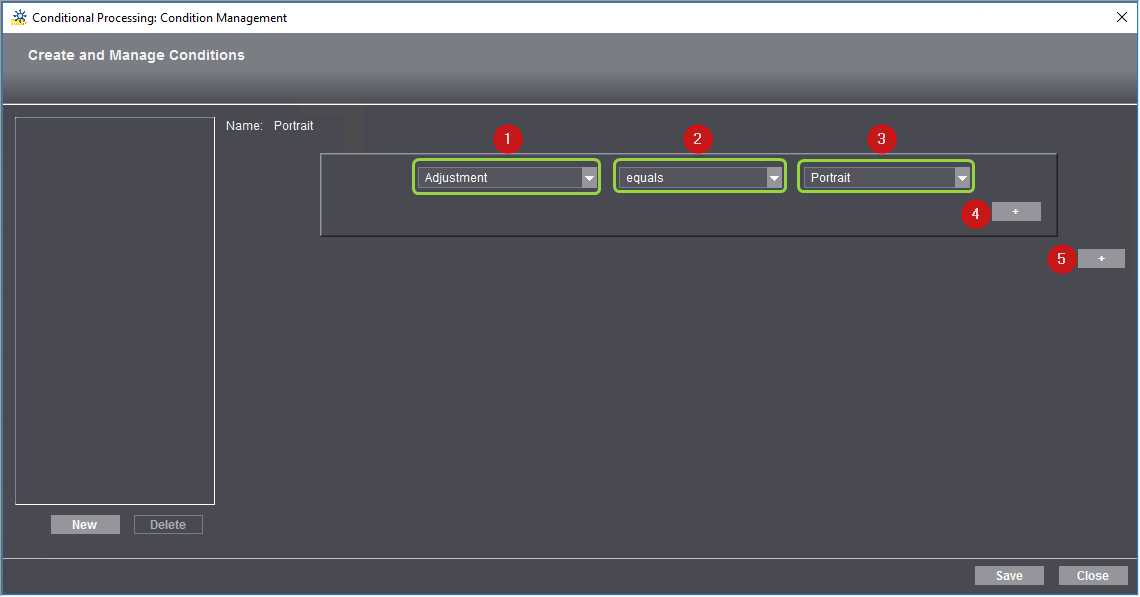
4.Select a parameter in the list box (1) to define the first condition. This list offers properties of PDF documents that are suited as selection criteria for conditional submission. The available options in boxes (2) and (3) change, depending on the property selected here. The "Adjustment" property serves as an example. In box (2), you can now select "equals" or "not equal". In box (3), you can select one of the properties "Portrait" or "Landscape". The condition could be: "Adjustment equals Portrait".
With this condition, all documents in Portrait orientation are submitted to a PageProof sequence (to be defined later).
5.You can add another condition by clicking the Plus button (4).

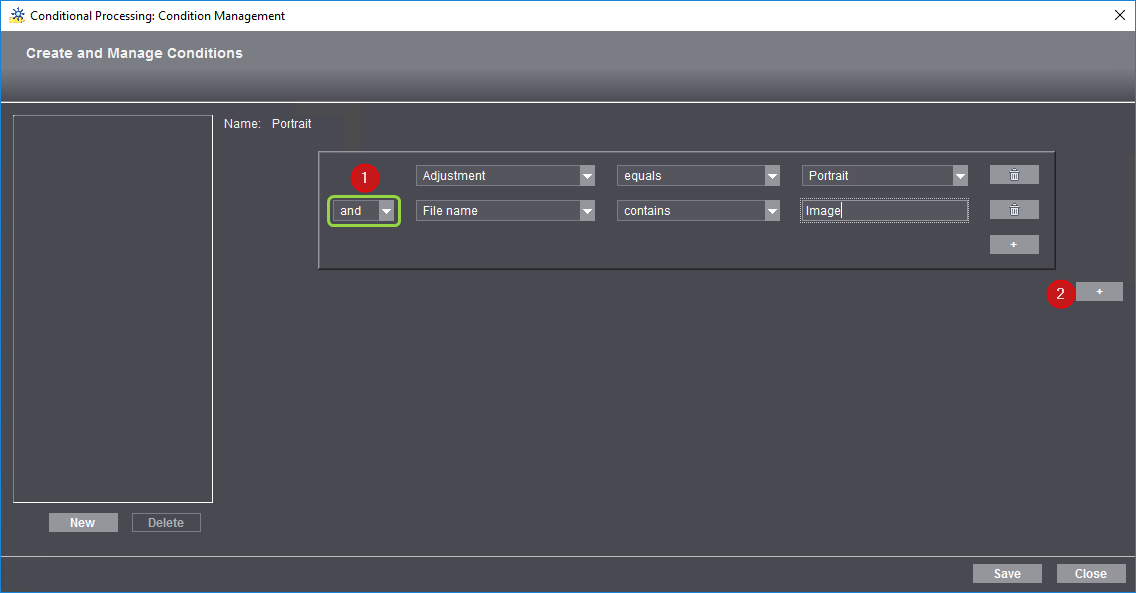
In box (1), you specify if the second condition is to also apply - "and" - (both conditions have to apply) or exclusively - "or" - (at least one condition has to apply. The same parameters as for the first condition are available for the other boxes.
In this way, you can set up a maximum of 7 supplementary conditions in addition to the main condition.
6.All Landscape pages are to be submitted to the PageProof sequence "HP_Designjet_Z5200CT". To do so, you need another main condition. You can add another main condition by clicking the Plus button (2).

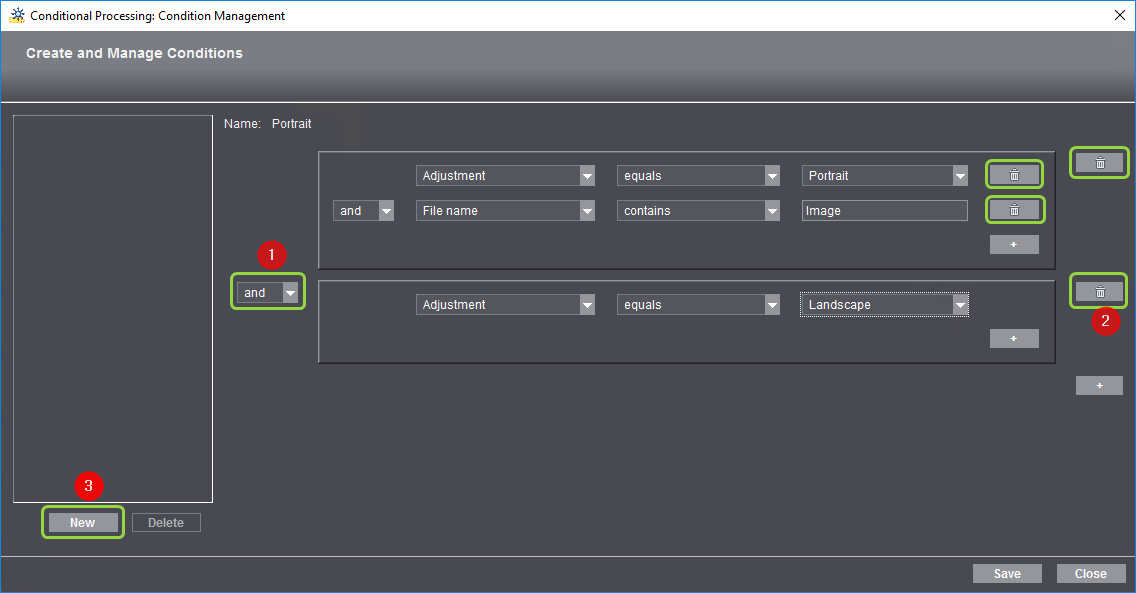
7.Here, you also specify with the list box (1) if the condition is to be effective as "and" or as "or". You can also define supplementary conditions to this main condition. You can define up to 8 main conditions.
If needed, click the pertaining Recycle Bin buttons (2) to delete any of the main or supplemental conditions.
8.Click "Save" to save the condition.
9.Click the "New" button (3) to generate a new condition. This will open a window where you can type the name of the condition.

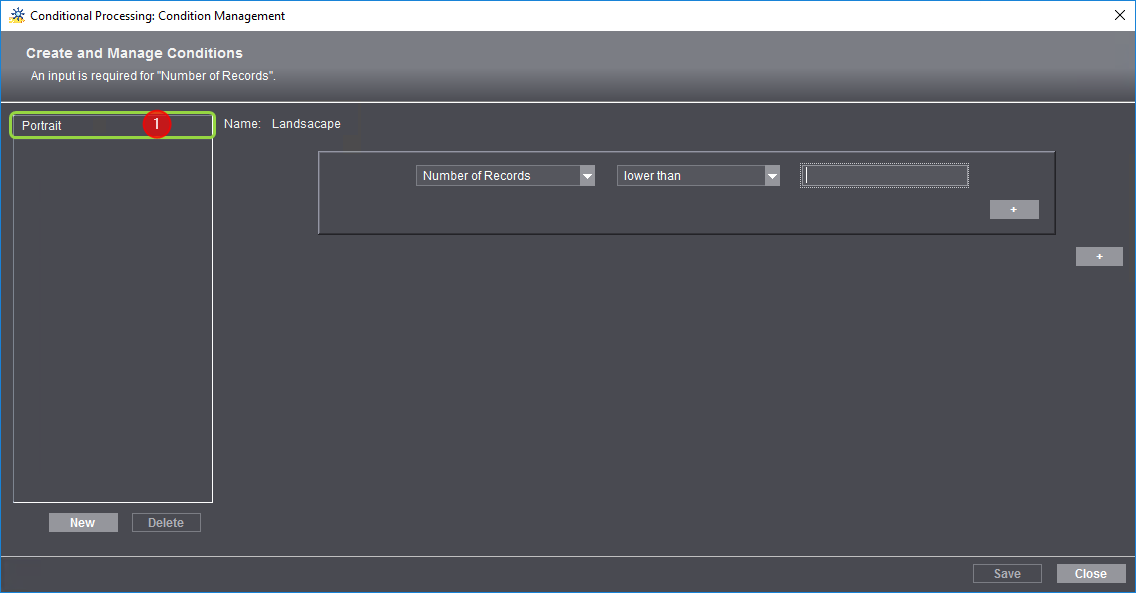
After confirming, the condition defined before will appear in the list box (1). In the right section of the window, you can set up the parameters of the new condition.
10.Click "New" to define new conditions without leaving the Editor window. With "Delete", you can delete items selected in the list.
11.Click "Close" to quit defining conditions.

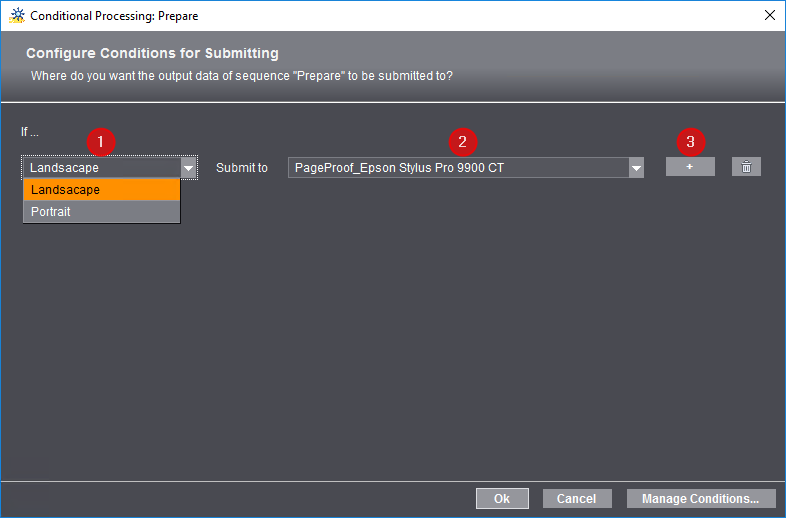
The "Configure Conditions for Submitting" window now lists the new conditions in the "If ..." list box (1). Now assign the submitting conditions to the various sequences.
12.In the "Submit to" list box you can select one of the available sequences suitable for submitting. Jobs complying with the conditions are submitted to this sequence automatically. In the example, the "Landscape" condition for submitting is assigned to the "PageProof_HP_Designjet_Z5200CT" sequence.
13.You can add an additional assignment of another submit condition to another sequence by clicking the Plus button (3). In the example, the "Portrait" condition for submitting is assigned to the "PageProof_Epson Stylus Pro 9900 CT" sequence.

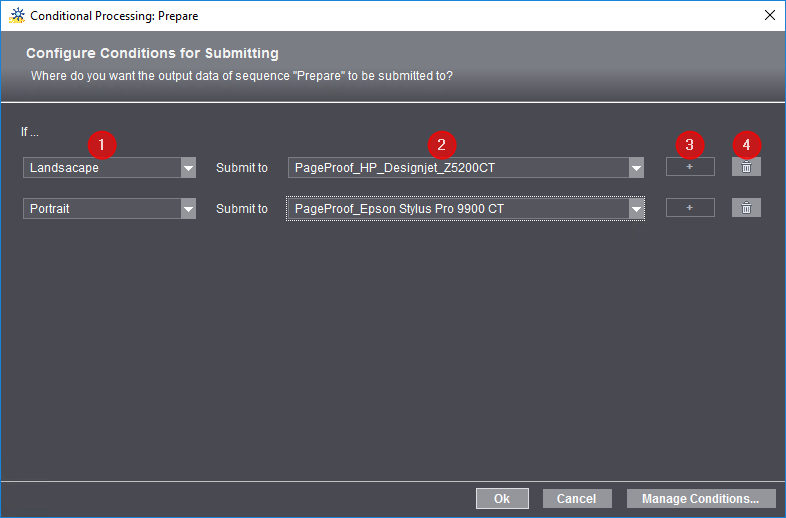
You can generate as many submit conditions as there are conditions and suitable sequences. In the present example, there are 2 suitable sequences; for this reason, only 2 conditions can be generated (no Plus button active). You can add any of the assignments by clicking the respective Recycle Bin button (4).
![]() Note: As a rule, only those pages are submitted that meet at least one of the conditions; pages not complying with any of the conditions will not be processed automatically. For this reason, it is feasible to always define a condition for which the "Else" (1) option is selected in the "If ..." list. In this case, all pages that do not comply with any of the defined conditions are submitted to the sequence assigned to "Else".
Note: As a rule, only those pages are submitted that meet at least one of the conditions; pages not complying with any of the conditions will not be processed automatically. For this reason, it is feasible to always define a condition for which the "Else" (1) option is selected in the "If ..." list. In this case, all pages that do not comply with any of the defined conditions are submitted to the sequence assigned to "Else".

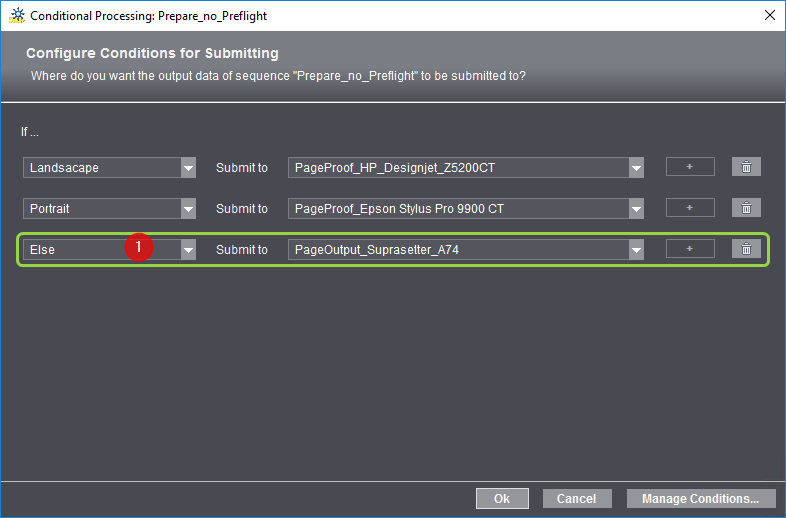
14.Save your settings for conditional submitting with "OK".
![]() Note: If you cancel editing, the dialog "Configure Conditions for Submitting" closes, and the conditions will not apply. The connecting lines are generated but all documents without conditions are submitted in parallel to both sequences, provided that both subsequent sequences are not "main" sequences (e.g. from a Qualify to two Prepare sequences). The conditions defined before (in the "Portrait" and "Landscape" examples) are not removed and can be used for later definitions.
Note: If you cancel editing, the dialog "Configure Conditions for Submitting" closes, and the conditions will not apply. The connecting lines are generated but all documents without conditions are submitted in parallel to both sequences, provided that both subsequent sequences are not "main" sequences (e.g. from a Qualify to two Prepare sequences). The conditions defined before (in the "Portrait" and "Landscape" examples) are not removed and can be used for later definitions.
The connecting lines now are displayed with the names of the set conditions.

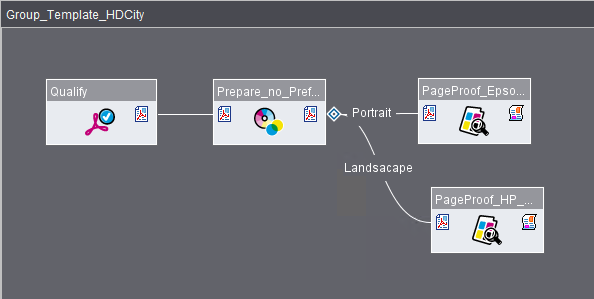
Double clicking the diamond icon or the link opens the "Configure Conditions for Submitting" dialog. If needed, you can edit the submit conditions or define new conditions here.
![]() Note: Once defined, submit conditions are available in the entire system for group templates and for smart templates. See also Conditional Submit Process.
Note: Once defined, submit conditions are available in the entire system for group templates and for smart templates. See also Conditional Submit Process.
Example 2: Automatic submit to certain product parts
In this example, pages that are assigned to different product parts (Cover, Content) are to be submitted to different PageProof sequences.

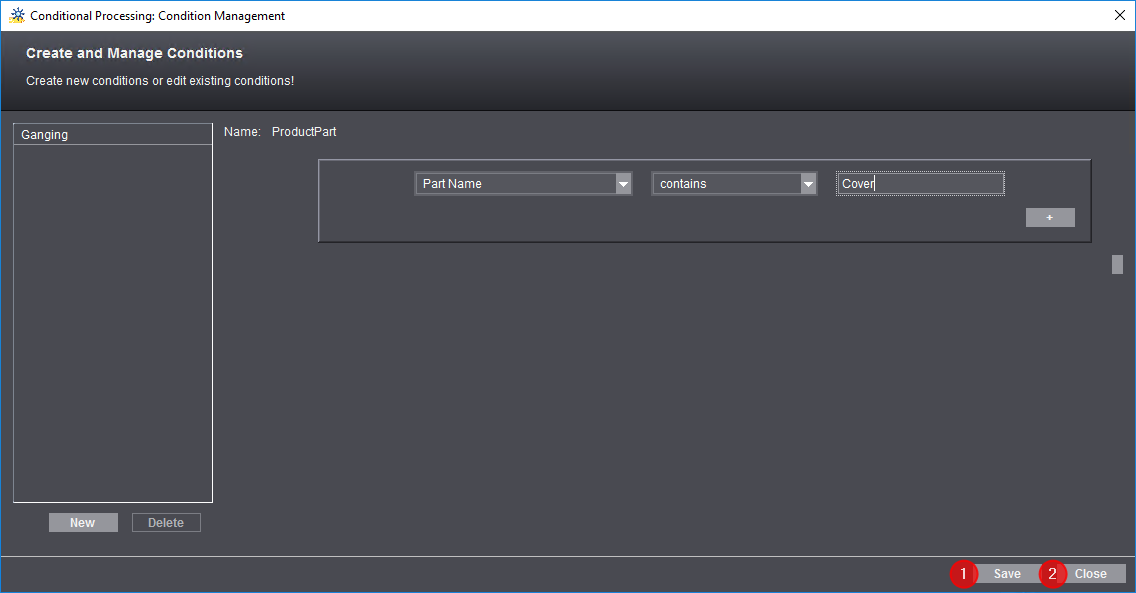
1.To do this, we define a new condition, "Product Part", with "Part Name contains Cover" as the parameters. With this condition, all pages whose product part name contains "Cover" will be submitted to the "PageProof_Epson7900" sequence. We save the condition (1) and then click "Close" (2).
2.All other pages are content pages and are to be submitted to another sequence, "PageProof_HP5500".

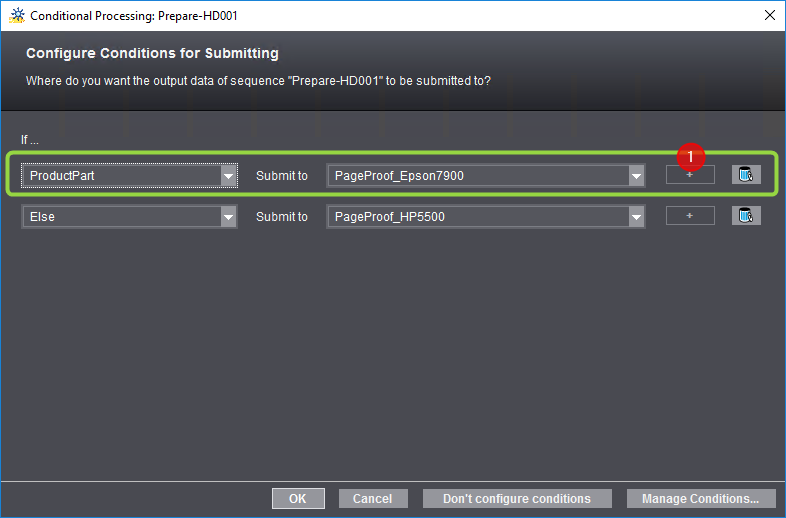
3.For this to be done, we set the following condition: "If Product Part Submit to PageProof_Epson7900" and click the "+" button (1). A new If-then relation opens. We set "If Else Submit to PageProof_HP5500" as the condition in these boxes. We confirm the dialog with "OK".
The resulting process network is as shown below:

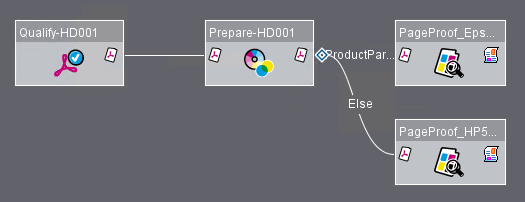
Example 3: Pages intended for ganging are to be submitted automatically to ganging
In this example, pages that are intended for ganging are to be submitted automatically to a special ganging Prepare sequence while all other pages will be submitted to a "normal" Prepare sequence. For this purpose, you can use the "Ganging Intended" submit condition:
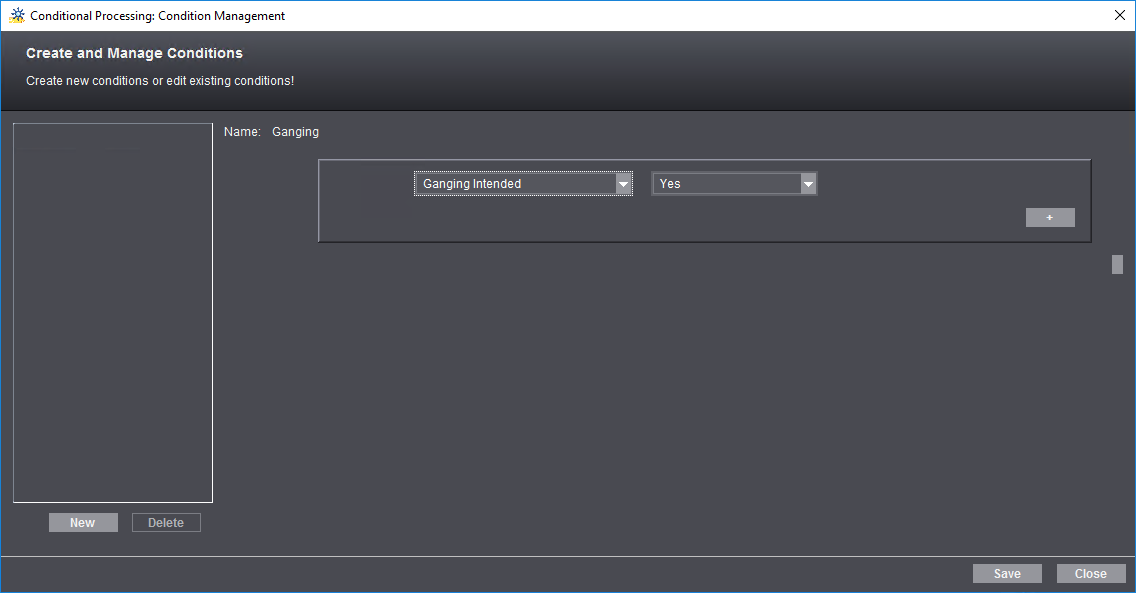
If you add an "Else" condition to this condition, you have the following branch condition, for example:
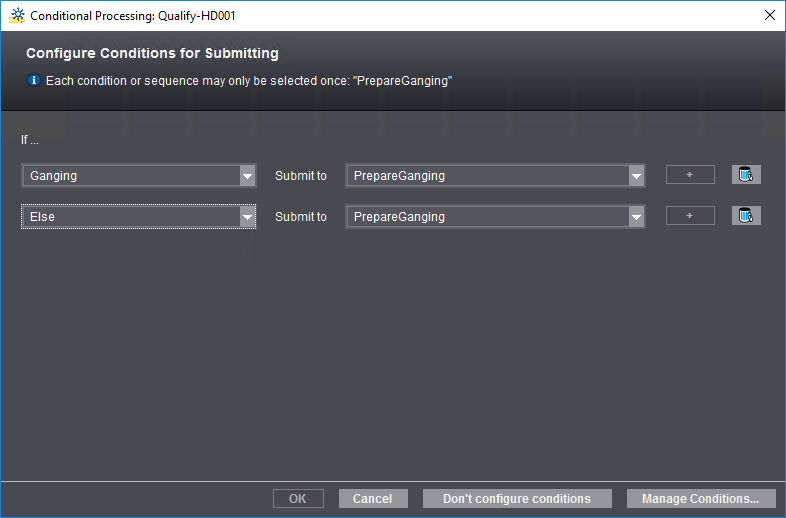
This lets you set up the following process network, for example:
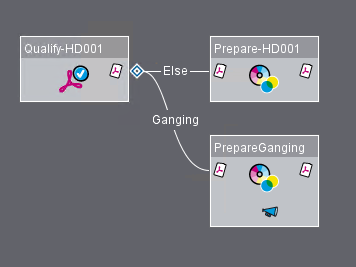
Deleting sequence templates from a group template
To remove a sequence from a group template, mark the sequence concerned and click "Delete" or use the shortcut "Command +Del".
Click "Save" to save the changes you made to an open group template.
Click "Save As..." if you wish to modify an existing group template and save it using a new name. The "Save Template" dialog opens:
Type a name that will be used when saving the group template and if necessary, type in a comment.
Click the "Close" button to close the group template. If the template was modified since it was last saved, a dialog opens where you can select whether you wish to save the changes or to close the template without saving. In this case, any changes made are lost. As a third option, you can cancel Close.
Privacy Policy | Imprint | Prinect Know How | Prinect Release Notes